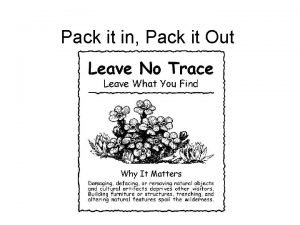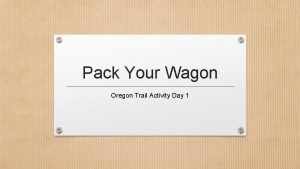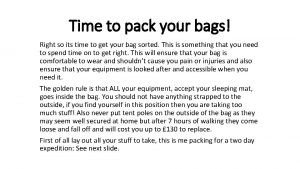How to pack your Rucksack How to pack














- Slides: 14

How to pack your Rucksack.

How to pack your Rucksack.

How to pack your Rucksack. • It is primarily the weather, the season and the number of day’s expedition you are going on that will determine what you carry and the order you pack it in. • The general rules are: • Choose what you take with care, you don't want to carry a rucksack heavy with items you won't use. • Good organisation is the key to a comfortable carry. Start by making three piles of equipment: • 1. Accessible for items - like water, medicines etc. • 2. Things you'll need that day. • 3. Things you won't need till the evening - like pj's and wash kit.

How to pack your Rucksack. • Pack the first pile last so the things you need to access easily are at the top. Remember - Rucksacks are NOT waterproof. • Pack those things you won't need till the night last and all the others in between. Remember that weight should be the deciding factor, not whether the item can be squeezed into the sack, so only pack essentials, and what it on the kit list. • When packing keep handy the things you will need en route in the side and lid pockets and the top of the sack. Other equipment should be divided into light, bulky items and heavy, dense items. • The sack should then be packed in a manner which keeps the weight high and close to your back and evenly distributed so one side isn't heavier than the other. Heavier items such as your food and Trangia should be packed close to the centre of gravity and nearer the top of the sack, but ensure they don't press against your back.

How to pack your Rucksack. • Place small items such as matches, penknife, torch, money etc. in a plastic bag and put it in the lid pocket. • Sleep-mats should only be strapped onto the rucksack and wrapped up in your emergency bivvy bag. • For the type of expedition you will be doing, a sack of around 65 litres is generally regarded as the best size. • The large amount of weight you will need to carry means that a stiffened back is needed for the sack to be a comfortable shape and large padded hip band ensures that much of the weight is transferred to the hips to reduce excessive loading on the shoulders and down the spine.

MAIN COMPARTMENT. • This is used to carry the majority of equipment and is loaded from the top and is partially closed by a draw cord, with the lid providing a weather-proof seal. • Many of these rucksack are extendible (i. e. the lid can be raised and the snow lock used for storage of extra gear) which can be useful for transporting extra equipment, not that you should have any. • In this main compartment you must have a big waterproof rubble suck, or rucksack liner, this will stop things inside getting wet. Rucksacks are NOT waterproof. • Ideally you should attempt to get everything into the rucksack; however larger items that do not need to be kept dry such as the tent or sleep-mat can be strapped on or under the lid.

BASE COMPARTMENT. • Accessed by a zipped entry, it may have compression straps to hold soft items such as sleeping bags securely. • The "shelf" dividing the main and base compartments can often be removed by means of a zip of draw cord to give the option of one large compartment. • Again, your sleeping bag is in here and it must be in a separate waterproof bag, you don't want to be sleeping in a damp sleeping bag!

LOADING STRAPS. • Compression/Accessory straps are those which run around the sides of a rucksack and are used to compress it so that the weight is held close to your back when the sack is partially full. • They also allow additional side pockets to be fitted to give extra space, or they can be used for attaching excess gear (sleeping bag mats, tent poles, walking poles etc. ) • Closure/ Profile Straps run vertically around the sack. At their top end they are used to hold the lid closed, but at the base there may be extra buckles which can be used to reduce the width of the base of the sack. • Again, these can be used in the same way as the compression/accessory straps, to put your bed roll, tent poles on etc. Don't forget to put your sleep-mat in a waterproof bag, (Bivvy Bag) the last thing you want after a long walk is to lay down on a spongy wet roll mat!

POCKETS. • The lid pocket is useful for carrying items which are most frequently needed when on the move, as the zip entry is usually behind the neck where it can just be reached. • Care is needed, however, to ensure that small items do not fall out of the pocket when it is opened. • It is good practice for others in the group to help you use these pockets, as your companion will be able to reach into these without you needing to take off the rucksack. • They can also be used for fuel bottles and things which may contaminate other gear. • We strongly advise inhalers and other medical essentials to be kept in a side pocket or in the lid pocket, so they can be quickly accessed by both the person wearing the bag, without having to take it off, and another team member.

LID. • Usually elasticised around the edges for a more weather-proof seal and held closed by snap fit buckles on the profile straps. • This provides scope for stowing a jacket or fleece if the weather becomes warmer. • Most will have a pocket in the lid. • Decide with your group if this is where you are going to keep any medical items.

ICE AXE LOOPS. • These are used to carry ice tools, which you will not need. • However they come in handy if you have just taken your jumper off and want somewhere to put it while you walk.

YOUR RUCKSACK. • Familiarise yourself with the rucksack that you are using, make sure that your rucksack is a comfortable fit. • Each rucksack has several adjustable parts to it and it may take some time to adjust it properly. • You will be shown how to adjust your rucksack to suit you, if you are having any trouble with this then come to one of the team leaders. • Remember your rucksacks maximum load isn't what it says on the bag, you are trying to carry only the essentials; therefore it should weigh no more than 25% of your body's weight. • MY WEIGHT IS. . . . KG, • SO MY RUCKSACK SHOULDN'T WEIGH MORE THAN. . . . KG.

How to pack your Rucksack. • Everyone should carry a first aid kit and carry it in the lid pocket. • The map and compass are not to be packed in the rucksack, carry and use them at all times, THEN YOU WON'T GET LOST! • LOOK AFTER YOUR RUCKSACK AND BE CAREFUL NOT TO CATCH IT ON BARBED WIRE! • DO NOT THROW YOUR RUCKSACK ON THE GROUND! • DAMAGE IS CAUSED TO TENT POLES ETC!

 Wie spricht man oft aus
Wie spricht man oft aus Pack it out pack it in
Pack it out pack it in Give us your hungry your tired your poor
Give us your hungry your tired your poor Oregon trail pack your wagon
Oregon trail pack your wagon Time to pack your bags
Time to pack your bags Coping with gay loneliness
Coping with gay loneliness Stop blaming your parents for your problems
Stop blaming your parents for your problems How does the heart work
How does the heart work A poem is a little path
A poem is a little path Introduce your friend to your teacher
Introduce your friend to your teacher R
R Write questions and answers in your notebook
Write questions and answers in your notebook In your notebook define the following terms in your words
In your notebook define the following terms in your words Change your water change your life
Change your water change your life Your conscious awareness of your own name and self identity
Your conscious awareness of your own name and self identity



























